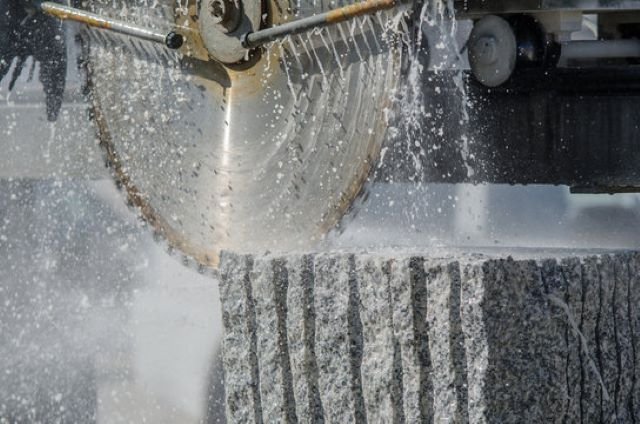Step 1 – Extraction of Marble Blocks
Stones occur in the form of natural rock masses or layers on the surface. The process of extraction of suitable stones from their natural rock beds or layers is commonly called Quarrying of Stones. We have many Rock Deposits or Rock Mines of White Marble, Green Marble and many more from where we extract the Marble Blocks or Granite Blocks.
Mining marble blocks from the wall of the quarry starts with a "bench wall." The bench wall is a large section of marble along a vertical wall that is cut with diamond cables, drills, and torches. Dynamite loosens the bench wall from the side of the quarry, and the separated wall can then be processed and cut into individual, uniform blocks. A marble block usually weighs between 15,000 and 25,000 pounds.


Step 2 – Process Before Block Cutting
After the blocks are extracted from the quarry, they'll go through further processing to match their intended purpose. From the quarry and until they are loaded onto containers ready for shipment, marble slabs go through different transformation phases.
Once each block is extracted from the quarry, these are classified based on certain quality criteria, such as:- Block size
- Tones
- Amount of streaks: the lower the amount of streaks, the higher quality and better classification.
- Cleanliness: clean materials are those with no stains
- Cracks
Due to their large dimensions and heavy weight, the blocks need to be moved and handled with cranes and specific machines, both during loading/ unloading and during processing.
Step 3 – Block Cutting
Marble slabs for construction or sculpture are cut using diamond wires or a gang saw, which uses multiple diamond-tipped blades to slice a marble block into more manageable slabs. Marble is cut using multiwire or block cutters. Depending on their dimensions, blocks may be cut using different methods, i.e., large blocks will be processed in the multi wire cutter, while smaller, irregular blocks will be cut using block cutters. The aim is to make the most of the block’s measurements by reducing any waste as much as possible.
Multiwire cutters will produce slabs. On the other hand, block cutters will produce strips that will be subsequently processed by the mitre saw or cutter in order to create tiles.


Step 4 – Fabrication & Polishing Of Stone Slabs
Slabs are taken to the production line for further processing. As a first step, the material is strengthened by attaching a mesh for further resistance.
Following, the marble is subject to an abrasion process in order to change its appearance and to produce different finishes:- Polishing: in this case we enhance the marble’s shine and colour by leaving a smooth, glossy surface. Polishing time will vary depending on the block dimensions. It can usually take between 45 and 60 minutes.
- Honing: consists of achieving a matt, shine free surface. Its main difference with the raw marble is that this finish removes all cutting marks.
- Ageing: this finish provides natural stonework with a rugged, shine free aspect resembling natural wear and tear.
- Bush hammering: produces a coarser finish providing additional grip, which makes it ideal for outdoor areas.
- Sanding: This finish achieves a much less coarse surface than the bush hammering process.
- Split face: this is the most rustic finish, which can achieve a very rugged surface.
And this would be the very last stage in the marble preparation process in the case of slabs that are ready for sale. Otherwise, the slabs would be subject to further cutting and finishing procedures.
Step 5 – After Finishing, Stone Slabs ready for Display
Once the corresponding finish has been applied, the slabs will be ready for display or will go directly to packaging ready for shipment.
If the marble slabs are being shipped abroad, a series of wooden bundles will be prepared in order to introduce them into containers. While if your slabs are being shipped within India, these are transported using iron a frames to hold them in place.
Tiles, on the other hand, are packed in wooden boxes for transportation.


Step 6 – Stone Installation for Royal look to Interiors
There is something very luxurious about the grand combination of misty veined marble and rich granite countertops. Floors, bathroom tiles and kitchen backsplashes have long been clad in marvellous marble finishes. Marble flooring is known for its superior, decent and decorative occurrence. It is considered a style symbol and also long lasting.
Marble floor is very easy to maintain and only requires occasional sweeping and polishing. The decors in this collection form the basis for a conscious and modern home decor where comfort and design excellence are perfectly balanced.
